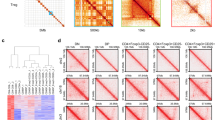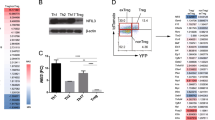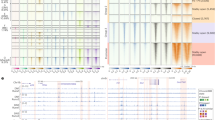Abstract
The transcription factor Foxp3 has an indispensable role in establishing stable transcriptional and functional programs of regulatory T cells (Treg cells). Loss of Foxp3 expression in mature Treg cells results in a failure of suppressor function, yet the molecular mechanisms that ensure steady, heritable Foxp3 expression in the Treg cell lineage remain unknown. Using Treg cell–specific gene targeting, we found that complexes of the transcription factors Runx and CBFβ were required for maintenance of Foxp3 mRNA and protein expression in Treg cells. Consequently, mice lacking CBFβb exclusively in the Treg cell lineage had a moderate lymphoproliferative syndrome. Thus, Runx-CBFβ complexes maintain stable high expression of Foxp3 and serve as an essential determinant of Treg cell lineage stability.
This is a preview of subscription content, access via your institution
Access options
Subscribe to this journal
Receive 12 print issues and online access
$209.00 per year
only $17.42 per issue
Buy this article
- Purchase on Springer Link
- Instant access to full article PDF
Prices may be subject to local taxes which are calculated during checkout







Similar content being viewed by others
References
Sakaguchi, S., Yamaguchi, T., Nomura, T. & Ono, M. Regulatory T cells and immune tolerance. Cell 133, 775–787 (2008).
Fontenot, J.D., Gavin, M.A. & Rudensky, A.Y. Foxp3 programs the development and function of CD4+CD25+ regulatory T cells. Nat. Immunol. 4, 330–336 (2003).
Hori, S., Nomura, T. & Sakaguchi, S. Control of regulatory T cell development by the transcription factor Foxp3. Science 299, 1057–1061 (2003).
Khattri, R., Cox, T., Yasayko, S.A. & Ramsdell, F. An essential role for Scurfin in CD4+CD25+ T regulatory cells. Nat. Immunol. 4, 337–342 (2003).
Williams, L.M. & Rudensky, A.Y. Maintenance of the Foxp3-dependent developmental program in mature regulatory T cells requires continued expression of Foxp3. Nat. Immunol. 8, 277–284 (2007).
Zheng, Y. et al. Genome-wide analysis of Foxp3 target genes in developing and mature regulatory T cells. Nature 445, 936–940 (2007).
Gavin, M.A. et al. Foxp3-dependent programme of regulatory T-cell differentiation. Nature 445, 771–775 (2007).
Marson, A. et al. Foxp3 occupancy and regulation of key target genes during T-cell stimulation. Nature 445, 931–935 (2007).
Burchill, M.A., Yang, J., Vogtenhuber, C., Blazar, B.R. & Farrar, M.A. IL-2 receptor β-dependent STAT5 activation is required for the development of Foxp3+ regulatory T cells. J. Immunol. 178, 280–290 (2007).
Yao, Z. et al. Nonredundant roles for Stat5a/b in directly regulating Foxp3. Blood 109, 4368–4375 (2007).
Tone, Y. et al. Smad3 and NFAT cooperate to induce Foxp3 expression through its enhancer. Nat. Immunol. 9, 194–202 (2008).
Kim, H.P. & Leonard, W.J. CREB/ATF-dependent T cell receptor-induced FoxP3 gene expression: a role for DNA methylation. J. Exp. Med. 204, 1543–1551 (2007).
Wu, Y. et al. FOXP3 controls regulatory T cell function through cooperation with NFAT. Cell 126, 375–387 (2006).
Ono, M. et al. Foxp3 controls regulatory T-cell function by interacting with AML1/Runx1. Nature 446, 685–689 (2007).
Speck, N.A. Core binding factor and its role in normal hematopoietic development. Curr. Opin. Hematol. 8, 192–196 (2001).
Tahirov, T.H. et al. Structural analyses of DNA recognition by the AML1/Runx-1 Runt domain and its allosteric control by CBFβ. Cell 104, 755–767 (2001).
Huang, G. et al. Dimerization with PEBP2β protects RUNX1/AML1 from ubiquitin-proteasome-mediated degradation. EMBO J. 20, 723–733 (2001).
Taniuchi, I. & Littman, D.R. Epigenetic gene silencing by Runx proteins. Oncogene 23, 4341–4345 (2004).
Giese, K., Kingsley, C., Kirshner, J.R. & Grosschedl, R. Assembly and function of a TCRα enhancer complex is dependent on LEF-1-induced DNA bending and multiple protein-protein interactions. Genes Dev. 9, 995–1008 (1995).
Sun, W., Graves, B.J. & Speck, N.A. Transactivation of the Moloney murine leukemia virus and T-cell receptor β-chain enhancers by cbf and ets requires intact binding sites for both proteins. J. Virol. 69, 4941–4949 (1995).
Hernandez-Munain, C. & Krangel, M.S. c-Myb and core-binding factor/PEBP2 display functional synergy but bind independently to adjacent sites in the T-cell receptor δ enhancer. Mol. Cell. Biol. 15, 3090–3099 (1995).
Hernandez-Munain, C. & Krangel, M.S. Regulation of the T-cell receptor δ enhancer by functional cooperation between c-Myb and core-binding factors. Mol. Cell. Biol. 14, 473–483 (1994).
Taniuchi, I. et al. Differential requirements for Runx proteins in CD4 repression and epigenetic silencing during T lymphocyte development. Cell 111, 621–633 (2002).
Djuretic, I.M. et al. Transcription factors T-bet and Runx3 cooperate to activate Ifng and silence Il4 in T helper type 1 cells. Nat. Immunol. 8, 145–153 (2007).
Naoe, Y. et al. Repression of interleukin-4 in T helper type 1 cells by Runx/Cbfβ binding to the Il4 silencer. J. Exp. Med. 204, 1749–1755 (2007).
Rubtsov, Y.P. et al. Regulatory T cell-derived interleukin-10 limits inflammation at environmental interfaces. Immunity 28, 546–558 (2008).
Kim, J.M., Rasmussen, J.P. & Rudensky, A.Y. Regulatory T cells prevent catastrophic autoimmunity throughout the lifespan of mice. Nat. Immunol. 8, 191–197 (2007).
Wan, Y.Y. & Flavell, R.A. Regulatory T-cell functions are subverted and converted owing to attenuated Foxp3 expression. Nature 445, 766–770 (2007).
Lin, W. et al. Regulatory T cell development in the absence of functional Foxp3. Nat. Immunol. 8, 359–368 (2007).
Daley, E. et al. Pulmonary arterial remodeling induced by a Th2 immune response. J. Exp. Med. 205, 361–372 (2008).
Taraseviciene-Stewart, L. et al. Absence of T cells confers increased pulmonary arterial hypertension and vascular remodeling. Am. J. Respir. Crit. Care Med. 175, 1280–1289 (2007).
Nicolls, M.R., Taraseviciene-Stewart, L., Rai, P.R., Badesch, D.B. & Voelkel, N.F. Autoimmunity and pulmonary hypertension: a perspective. Eur. Respir. J. 26, 1110–1118 (2005).
Livak, K.J. & Schmittgen, T.D. Analysis of relative gene expression data using real-time quantitative PCR and the 2−ΔΔCT method. Methods 25, 402–408 (2001).
Hsieh, C.S. et al. Recognition of the peripheral self by naturally arising CD25+CD4+ T cell receptors. Immunity 21, 267–277 (2004).
Acknowledgements
We thank M. Tone (University of Pennsylvania) for the reporter construct containing the Foxp3 promoter; K. Forbush, T. Chu and L. Karpik for managing the mouse colony; and I. Taniuchi, Y. Tone and M. Tone for advice. Supported by the National Institutes of Health (A.Y.R.), the Arthritis Foundation (D.R.), the Leukemia and Lymphoma Society (T.E.), the Helen and Martin Kimmel Center for Stem Cell Biology (M.M.W.C.) and the Howard Hughes Medical Institute (A.Y.R. and D.R.L).
Author information
Authors and Affiliations
Contributions
D.R. designed and did experiments, analyzed the data and cowrote the manuscript with A.Y.R.; T.E., M.M.W.C. and D.R.L. generated and analyzed Runx1fl/flFoxp3YFP-Cre mice and Cbfbfl/flCD4-Cre+ mice; P.T. did histopathology analysis; and A.Y.R. designed experiments with D.R., analyzed the data and cowrote the manuscript with D.R.
Corresponding author
Supplementary information
Supplementary Text and Figures
Supplementary Figures 1–8 and Supplementary Table 1 (PDF 3664 kb)
Rights and permissions
About this article
Cite this article
Rudra, D., Egawa, T., Chong, M. et al. Runx-CBFβ complexes control expression of the transcription factor Foxp3 in regulatory T cells. Nat Immunol 10, 1170–1177 (2009). https://doi.org/10.1038/ni.1795
Received:
Accepted:
Published:
Issue Date:
DOI: https://doi.org/10.1038/ni.1795
This article is cited by
-
Pan-cancer analysis reveals PDK family as potential indicators related to prognosis and immune infiltration
Scientific Reports (2024)
-
Fatty acid desaturation by stearoyl-CoA desaturase-1 controls regulatory T cell differentiation and autoimmunity
Cellular & Molecular Immunology (2023)
-
PD-L2 controls peripherally induced regulatory T cells by maintaining metabolic activity and Foxp3 stability
Nature Communications (2022)
-
CRISPR screen in regulatory T cells reveals modulators of Foxp3
Nature (2020)
-
Selective deployment of transcription factor paralogs with submaximal strength facilitates gene regulation in the immune system
Nature Immunology (2019)



